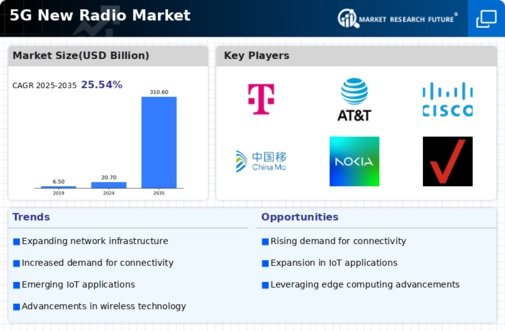Market Growth Projections
The Global 5G New Radio Market Industry is characterized by robust growth projections, reflecting the transformative potential of 5G technology. With an expected market value of 20.7 USD Billion in 2024, the industry is set to expand significantly, driven by various factors including increased demand for connectivity and the proliferation of IoT devices. The market is projected to achieve a staggering CAGR of 27.92% from 2025 to 2035, indicating a strong upward trajectory. This growth is likely to be supported by ongoing technological advancements and strategic investments from key stakeholders, positioning 5G as a cornerstone of future telecommunications.
Expansion of IoT Applications
The Global 5G New Radio Market Industry is significantly influenced by the expansion of Internet of Things (IoT) applications. As industries increasingly adopt IoT solutions for automation and data collection, the need for reliable and high-speed connectivity becomes paramount. The anticipated growth in IoT deployments is expected to drive the market to an estimated 310.6 USD Billion by 2035. This growth is likely to be fueled by sectors such as healthcare, manufacturing, and smart cities, where real-time data exchange and low latency are critical. Consequently, 5G technology is positioned as a vital enabler of these advancements, facilitating a more interconnected world.
Increased Mobile Data Traffic
The Global 5G New Radio Market Industry is witnessing a remarkable increase in mobile data traffic, driven by the proliferation of smartphones and mobile applications. As consumers demand more data-intensive services, such as video streaming and online gaming, the existing 4G infrastructure struggles to meet these needs. The transition to 5G technology is anticipated to alleviate these pressures, offering enhanced capacity and speed. This shift is expected to be a key driver of market growth, as operators invest in upgrading their networks to accommodate the rising data consumption. The growing reliance on mobile connectivity underscores the necessity for advanced technologies like 5G.
Advancements in Network Infrastructure
Advancements in network infrastructure are pivotal to the evolution of the Global 5G New Radio Market Industry. The deployment of advanced technologies, such as Massive MIMO and beamforming, is enhancing the efficiency and performance of 5G networks. These innovations enable operators to optimize their existing resources while expanding coverage and capacity. As a result, the market is poised for substantial growth, with projections indicating a potential market size of 310.6 USD Billion by 2035. The continuous improvement of network infrastructure not only supports the increasing demand for high-speed connectivity but also fosters the development of new applications and services that leverage 5G capabilities.
Government Initiatives and Investments
Government initiatives and investments play a crucial role in propelling the Global 5G New Radio Market Industry forward. Many countries are actively promoting the deployment of 5G networks through funding and policy support, recognizing the technology's potential to drive economic growth and innovation. For instance, various governments have allocated substantial budgets for infrastructure development, which is expected to enhance connectivity and stimulate market growth. These efforts are likely to create a conducive environment for the adoption of 5G technology, thereby contributing to an impressive CAGR of 27.92% from 2025 to 2035, as nations strive to remain competitive in the global digital economy.
Rising Demand for High-Speed Connectivity
The Global 5G New Radio Market Industry is experiencing a surge in demand for high-speed connectivity, driven by the increasing reliance on digital services across various sectors. As businesses and consumers seek faster internet speeds, the market is projected to reach 20.7 USD Billion in 2024. This demand is particularly evident in urban areas, where the proliferation of smart devices and IoT applications necessitates robust network capabilities. The integration of 5G technology is expected to enhance user experiences, enabling seamless streaming, gaming, and remote work functionalities, thereby solidifying its position in the global telecommunications landscape.















